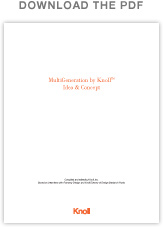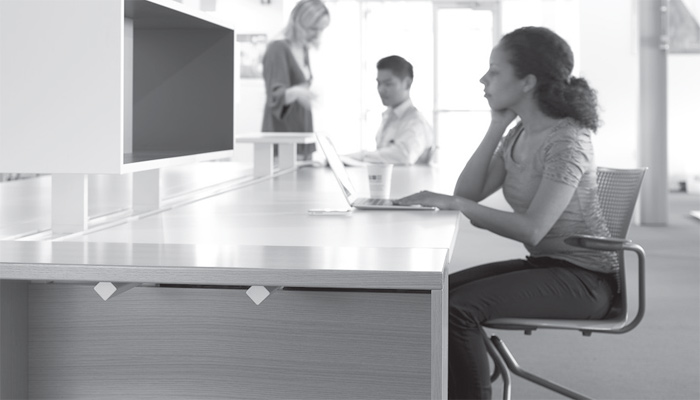
With the launch of Generation by Knoll in the spring of 2009, Knoll unveiled a new seating standard based on the concept of elastic design. The new work chair not only responds automatically to its users, but also it reveals how design is able to reconcile the seemingly conflicting demands of the need for continuous support and the desire for freedom of movement. Generation is not an either/or chair. It offers a both/and proposition: it provides comfort and unrestrained movement, durability and flexibility. Working again with Formway Design, the New Zealand-based collaborative responsible for the design of Generation, Knoll extends its foray into dynamic seating to create a family of products with similar attributes. The first offspring is a multipurpose chair, aptly called MultiGeneration by Knoll.
MultiGeneration could be called a conventional “side chair” or “guest chair,” but these terms dismiss the ubiquity of its use as a multipurpose chair—in shared (1:1), team (9:1), and large group (99:1) applications in a wide range of corporate, educational and healthcare settings. While it can play a supporting role to the attention-getting, high-performance Generation work chair, it can also serve a wider audience as a standalone seating solution.
The demand for flexible complementary seating is growing in today’s evolving workplace, particularly as organizations of all types come to appreciate the importance of fostering a collaborative culture to drive innovation, recognizing that work occurs in enclosed and open offices as well as more informal gathering spaces, individually and in small and large groups. As the new collection of Knoll office furniture called Antenna™ Workspaces demonstrates, there is an increasing need to remove the traditional barriers among colleagues to create environments that allow effortless and often spontaneous transitions between different work modes. In turn, the primary work seating must be flexible and responsive to support multiple postures; and the secondary, complementary seating should support not only a variety of uses but also the individual and collective experiences in collaborative work spaces.
Sitting Is Not a Static State
The members of the Formway team are as much keen observers of human behavior as product designers. Comprised of industrial designers, engineers, materials experts and marketing staff, Formway is research driven. As a result, the team spends nearly as much time articulating a design brief as designing the eventual product. In the case of MultiGeneration, the key of what they call their “empathetic insights” was that shifting positions while working is not symptomatic of a lack of focus, but rather the contrary: movement—from tapping our feet, twirling our pens, or even doodling—keeps us alert. Or as Formway Senior Designer Leif Roy and his colleagues explain, the central thesis behind MultiGeneration is that, “We fidget to focus.”
Therefore, the overall concept for MultiGeneration was not to inhibit movement but to allow for and encourage it, while still providing adequate support. It’s a delicate balance between physical support and responsiveness, as Formway discovered in evaluating popular products already in the market. Formway found through its research that these products often left users feeling fixed into a bucket-like mold that didn’t accommodate informal positions, such as sitting sideways. Wanting MultiGeneration to support a wide range of postures and to avoid a “locked in” sensation, Formway closely considered its seat and back contours and base types to arrive at a shape and attributes that are the most conducive to comfort and movement.
Designing with 270 Degree Sitting in Mind
The resulting open form of the MultiGeneration chair encourages natural movement and personal expression, supporting 270 degrees of sitting. “The design language of the solution indicates the performance of the chair,” maintains Roy, who points out that visual clues project an overall air of buoyancy and responsiveness. The back curvature allows for upper body movement and supports the lower back for upright, interactive postures. The seat features a gently contoured seat pan and unobstructed waterfall edges on three sides that allow users to move and support various postures. The cantilever arms feature contoured arm pads with smooth interior surfaces to lean against when side sitting. A rolled top edge provides an armrest for side sitting as well as a handle for easy transport. The passive flex in the shell—which is not achieved via a mechanical device, but is a function of the chair’s materials and construction—promotes comfort and movement. The perforated back coordinates with the Generation Flex Back, allows for air flow and provides a light aesthetic. The MultiGeneration form implies movement, says Knoll Director of Design Benjamin Pardo, who points out “typically we think of chairs as obedient, but they are actually tools to support people.”
The optional hybrid base for MultiGeneration is a unique design solution that combines the comfort of a cantilever form with a sturdy four-leg construction, giving the option of mobility from casters and freeing up the front corners for various postures. Formway developed this unique base to offer the benefits of traditional base types while removing some of their constraints. Cantilevered chairs have dynamic frames that respond to a user’s weight, but they cannot accommodate casters—which are desirable in a multipurpose chair—and they typically have front leg structures that can limit the user’s leg movement. Four-leg chairs are sturdy, allow for casters and are good for stacking, but they don’t have a dynamic frame. Formway selected the most desirable attributes of the traditional base types to create the MultiGeneration hybrid base, a melding of cantilever and four-leg constructions. The combination results in a design that responds to the user’s weight and allows 270 degrees of sitting on a mobile base with legs that are set back from the perimeter of the seat pan, unlocking users from a fixed position. The design has a graceful and seamless aesthetic with a fluidity expressed by the extenuated back legs.
The standard stacking base model of MultiGeneration is lightweight at 12 pounds and can be easily stacked and transported when not in use. Both the stacking and hybrid models rely on easily obtainable materials—tubular steel, for example—and use minimal parts in keeping with the Knoll commitment to sustainability. Of the chair’s overall composition, Pardo observes: “Simple products are timeless and adapt best to changes in technology.”
DOWNLOAD "MULTIGENERATION BY KNOLL IDEA & CONCEPT" TO READ THE FULL PAPER



















